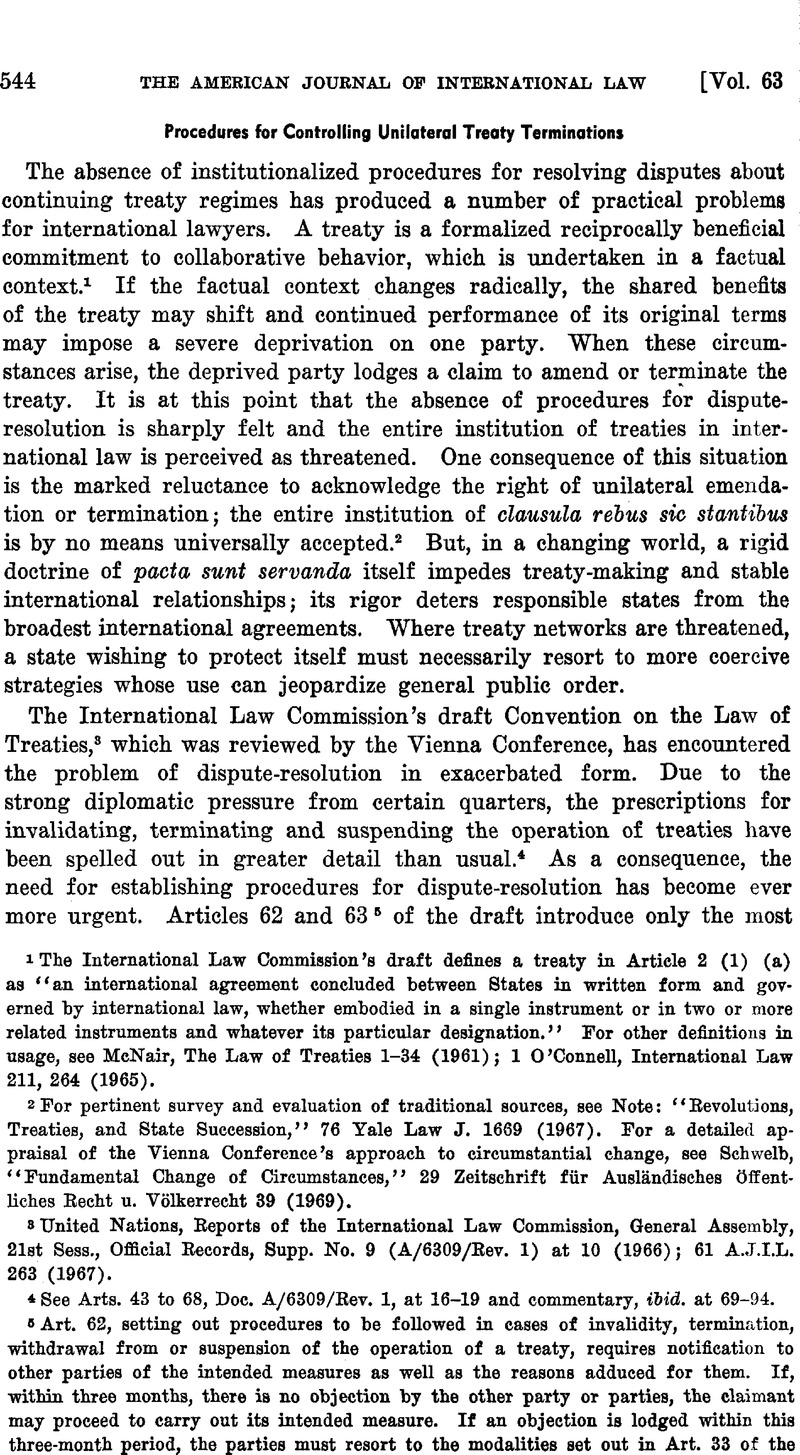No CrossRef data available.
Published online by Cambridge University Press: 28 March 2017

1 The International Law Commission's draft defines a treaty in Article 2 (1) (a) as ” a n international agreement concluded between States in written form and governed by international law, whether embodied in a single instrument or in two or more related instruments and whatever its particular designation.” For other definitions in usage, see McNair, The Law of Treaties 1-34 (1961); 1 O'Connell, International Law 211, 264 (1965).
2 For pertinent survey and evaluation of traditional sources, see Note: “Revolutions, Treaties, and State Succession,” 76 Yale Law J. 1669 (1967). For a detailed appraisal of the Vienna Conference's approach to circumstantial change, see Schwelb, “Fundamental Change of Circumstances,” 29 Zeitschrift für Ausländisches Öffentliches Recht u. Völkerrecht 39 (1969).
3 United Nations, Reports of the International Law Commission, General Assembly, 21st Sess., Offcial Records, Supp. No. 9 (A/6309/Rev. 1) at 10 (1966); 61 A.J.I.L. 263 (1967).
4 See Arts. 43 to 68, Doc. A/6309/Rev. 1, at 16-19 and commentary, Hid. at 69-94.
5 Art. 62, setting out procedures to be followed in cases of invalidity, termination, withdrawal from or suspension of the operation of a treaty, requires notification to other parties of the intended measures as well as the reasons adduced for them. If, within three months, there is no objection by the other party or parties, the claimant may proceed to carry out its intended measure. If an objection is lodged within this three-month period, the parties must resort to the modalities set out in Art. 33 of theto Art. 63, be by written instruments with an indication of the full powers of the signatory if he does not fall in the category of officials deemed, under international law, to have full powers as set out in Art. 6 of the draft.
6 Charter Art. 33 (1) provides: “The parties to any dispute, the continuance of which is likely to endanger the maintenance of international peace and security, shall, first of all, seek a solution by negotiation, enquiry, mediation, conciliation, arbitration, judicial settlement, resort to regional agencies or arrangements, or other peaceful means of their own choice.” Draft Art. 62 refers only to the modalities of Charter Art. 33; the renvoi does not include the peremptory obligation implied in the language “the parties … shall … ” This peremptory obligation would come into operation, without reference to the draft convention on treaties, if the dispute were deemed by the Security Council to constitute a “threat to the peace” within the meaning of Art. 39 of the Charter.
7 The text of Art. 62 bis was circulated at the United Nations Conference on the Law of Treaties as A/Conf. 39/C.l/L.352/Bev.2, May 21, 1968; reprinted below, p. 690. It was apparently discussed at the recent Asian-African Consultative Committee meeting in Karachi. An eloquent defense of the principles set out in Art. 62 bis was delivered by the observer for the American Society of International Law, Professor McDougal; the text of his address is reprinted below, in the Documents section of this JOURNAL, p. 685. To my mind, the chief operational weakness of Art. 62 Ms is found in the pivotal role assigned to the Secretary General. He is authorized to constitute the arbitral tribunal if the parties themselves are unable to reach agreement. Presumably, he will not appoint a tribunal if he deems it politically unwise from the perspective of his office's future activities. See, in this regard, the hesitations of the Secretary General in the Peace Treaties case, [1950] I.C.J. Eep. 65, 221. Nor is the President of the International Court of Justice, in a r61e as appointing authority, immune from such political considerations. See [1952] I.C.J. Rep. 93 and [1952-53] I.C.J. Yearbook 45.
8 For general survey, see United Nations, Systematic Survey of Treaties for the Pacific Settlement of International Disputes (1948); Jenks, 47 Annuaire de l'Institut de Droit International 54 (I).
9 See the Secretariat Commentary on the Draft Law of Treaties, A/CN.4/92 at 9-16, 26.
10 See Eeisman, “Revision of the South West Africa Cases,” 7 “Va. J. Int. Law 1, 31-32 (1966) and references there. But cf. De Visscher, “Reflections on the Present Prospects of International Adjudication,” 50 A.J.I.L. 467 (1956).
11 Interpretation of Peace Treaties with Bulgaria, Hungary and Romania, [1950] I.C.J. Rep. 65, 221; 44 A.J.I.L. 742, 752 (1950).
12 IbId
13 [1950] I.C.J. Rep. at 229.
14 See note 9 above; for text of I.L.C. draft, see 53 A.J.I.L. 239 at 241 (1959).